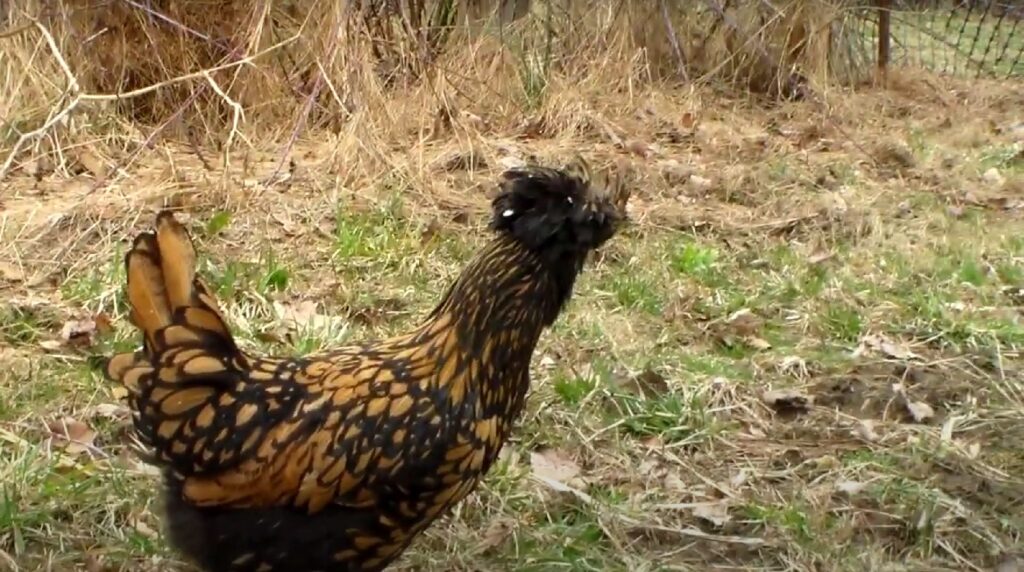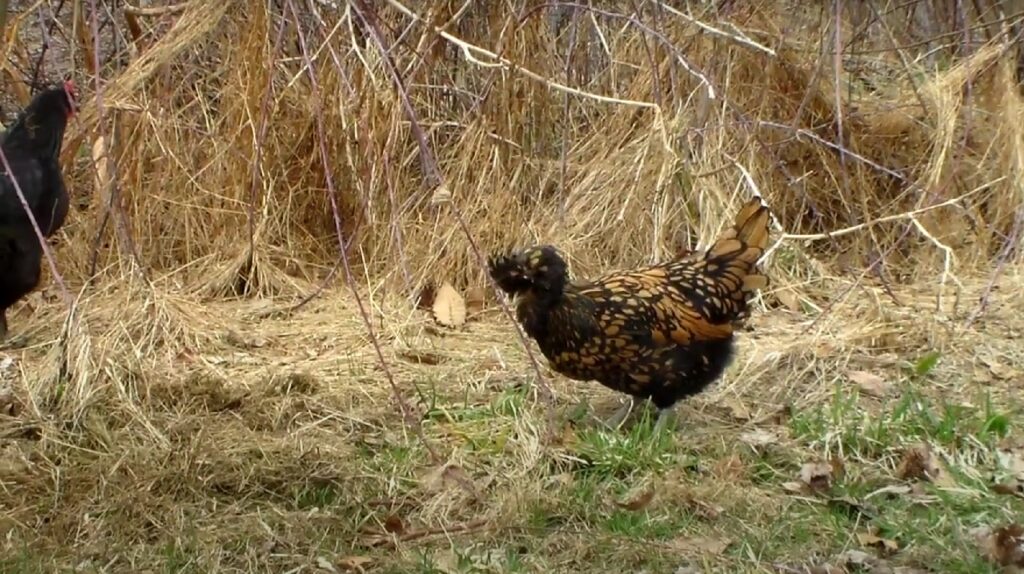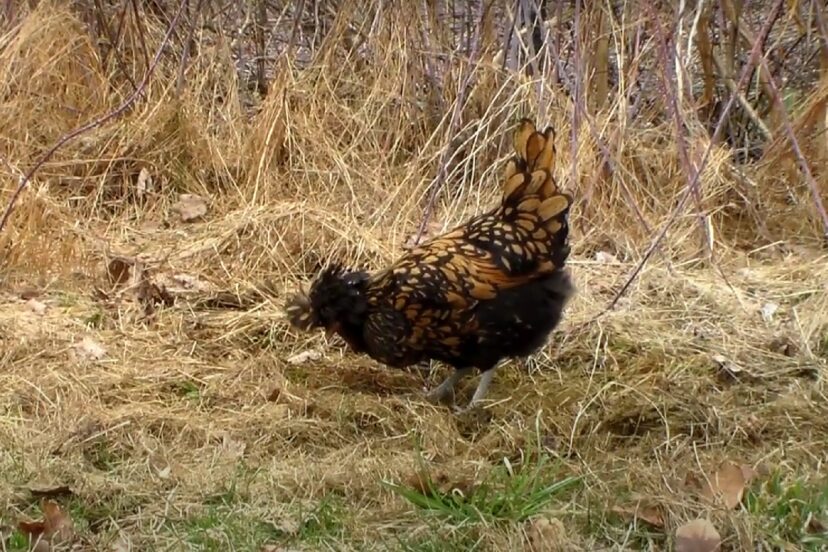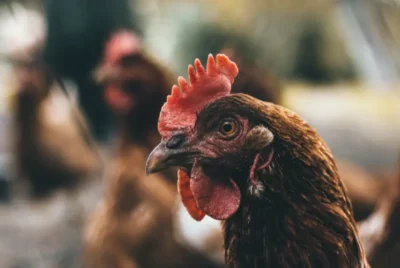Gold Polish Chicken Breed: Adding Brilliance to Your Flock
Choosing the right chicken breed for your flock is important, and the Gold Polish Chicken is a beautiful option that can make your flock stand out. However, adding this breed to your flock comes with its own set of challenges.
So, in this article, we’ll explore the ups and downs of adding Gold Polish Chickens to your coop, helping you make the most of their beauty and productivity
Quick Overview of Gold Polish Chicken
- Appearance: Medium-sized, with a striking large crest that almost covers the entire head.
- Size: Males weigh around 6 lbs (2.75 kg), and females weigh about 4.5 lbs (2 kg).
- Temperament: Generally friendly and docile.
- Egg Production: Good layers; typically lay around 200 white eggs per year.
- Egg Color: White.
- Purpose: Primarily kept for ornamental purposes, but also valued for their egg-laying capabilities.
- Hardiness: Moderately hardy; they require protection from the cold due to their large crests and can struggle with wet conditions.
- Cold Tolerance: Not really
- Care Requirements: Need regular grooming to maintain feather condition, especially around the crest. Protection from predators is important due to their limited vision.
- Lifespan: Can live up to 7-8 years with proper care.
- Special Considerations: Due to their crested heads, they can have sight issues and require extra care to ensure they are safe and can access food and water easily.
What to Breed to Get a Gold Polish Chicken
To breed a Gold Polish Chicken, you would typically start with parent birds that possess the desired gold coloration and the distinctive Polish chicken characteristics, such as the large, feathered crest on their heads.
Breeding two Gold Polish Chickens together is the most straightforward method to produce offspring with the same gold coloration and breed traits. However, if you’re starting with a broader genetic base, you can select for the gold coloration and other desired traits over several generations by carefully choosing parent birds that exhibit or carry these traits.
It’s important to maintain genetic diversity while selecting specific characteristics to ensure the health and vitality of the chickens. Polish chickens come in various colors, so focusing on gold-colored birds for breeding will help achieve the desired golden offspring.

Physical Characteristics of Gold Polish Chicken
- Feather Crest: One of the most distinctive features of Gold Polish chickens is their large, poufy feather crest, which resembles a pom-pom or a hat. This crest is made up of feathers that grow upward and outward from the top of their heads.
- V-Shaped Comb: Gold Polish chickens have a unique V-shaped comb, which is often difficult to see because it’s hidden by the crest of feathers.
- Beard and Muffs: They typically have beards and muffs, which are clusters of feathers that grow under their beaks and around their faces, adding to their unique and somewhat eccentric appearance.
- Coloration: As their name suggests, Gold Polish chickens have a gold or golden-yellow plumage. The exact shade can vary, with some birds having a bright, vibrant gold color, while others may have a more subdued or lighter shade. Some Gold Polish chickens also have black lacing or patterns in their feathers, which can add to their visual appeal.
- Body Size: Gold Polish chickens are generally considered to be a small to medium-sized breed. Hens weigh around 4.5 pounds, and roosters weigh about 6 pounds.
- Eyes: They have large, prominent eyes, which, combined with their crest, can sometimes limit their vision.
- Skin and Legs: They have white skin and slate-blue legs, adding to their distinctive appearance.
Behavior and Temperament of Gold Polish Chicken
The Gold Polish Chicken, known for its distinctive appearance and crest of feathers, exhibits quite sociable behavior within flock dynamics. They tend to be less dominant and they are in the lower pecking order, which can sometimes lead to them being bullied by more assertive breeds. Despite this, they generally get along well with other chickens, especially if raised together from a young age.
When it comes to interaction with humans and pets, Gold Polish Chickens are friendly and can become quite tame if handled regularly from an early age. Their curious nature often makes them interesting pets that may interact well with humans, though their vision can be obstructed by their feathered crest.
Regarding activity levels and foraging behavior, Gold Polish Chickens are active and enjoy foraging, making them excellent at insect control in a garden. They have a good level of energy and appreciate having space to explore and forage. However, their foraging might be slightly impeded by their crest limiting their vision, so they rely on their keepers to ensure their environment is safe and secure from predators.
Care Requirements for Gold Polish Breed

Housing Requirements
Polish chickens adapt well to confinement but do not require excessive space due to their size. They need at least four square feet per bird within the coop and more space outside for optimal comfort.
It’s crucial to provide dry quarters during winter months, as they don’t fare well in extremely wet or cold conditions. Their distinctive head feathers can become wet and freeze, so it’s essential to keep them in a draft-proof shelter during cold spells.
You might consider using a heat lamp in the coop to warm it up during damp weather because they are not cold tolerance.
Feeding and Nutrition
For adult Polish chickens, a regular 16% protein feed during the laying season is recommended, shifting to a 20% protein feed during molting to support feather regrowth. Free feeding or a set feeding regime can be utilized according to your convenience.
Polish chickens are good foragers and can find much of their food, reducing the need for excessive feeding. However, a nutritionally complete laying feed is still advisable for their diet.
Diet Specifics for Optimal Health
Supplementing their diet with extra protein is beneficial, especially during molting when chickens replace their feathers. Supplements like oyster shell can provide additional calcium, necessary for strong eggshells.
Providing plenty of nest boxes with clean bedding and ensuring a stress-free environment can also help stimulate natural egg laying.
Supplements and Treats
Calcium supplements, such as crushed oyster shell, should be provided to laying hens to ensure the production of strong eggshells. Treats can include fruits, vegetables, and protein-rich snacks like mealworms, but these should be given in moderation to avoid nutritional imbalances.
Additional Care Tips
Polish chickens have a bony prominence on their heads that doesn’t fuse immediately after hatching, making young chicks vulnerable to injury from pecking. It’s crucial to monitor chicks closely during their first weeks.
Regular checks for lice, mites, or other parasites are essential due to their dense feathering, especially around the head.
To prevent feather pulling and cannibalistic behavior among other breeds, applying a product cover and protecting wounds can be beneficial.
Polish chickens are gentle and can be toward the lower end of the pecking order due to their calm nature and head feathers. They thrive in environments where they can roam and explore but may require protection from more assertive breeds.
If mixed with other flocks, consider pairing them with similarly docile breeds to prevent bullying.
Common Health Issues and Prevention
- Predisposition to Respiratory Diseases: The feathered crest can sometimes obstruct the bird’s vision, leading to stress and susceptibility to respiratory diseases. Keeping their living area clean and well-ventilated can help minimize this risk.
- Vulnerability to Parasites: The dense plumage of the Gold Polish makes them particularly attractive to parasites like lice and mites. Regular checks and maintaining good coop hygiene are essential preventative measures.
- Eye Infections: The crest feathers can irritate the eyes, leading to infections. Trimming the feathers around their eyes carefully can help prevent this issue.
- Frostbite: In colder climates, the large comb and wattles of some Polish chickens can be prone to frostbite. Providing a well-insulated and dry coop during the winter months is important.
- Marek’s Disease: While not specific to the Gold Polish breed, Marek’s disease is a concern for all poultry. Vaccination at an early age can protect against this viral disease.
- Fatty Liver Hemorrhagic Syndrome: This condition, often resulting from a high-energy diet with low exercise, can be a concern, especially for backyard flocks that might not forage as extensively. Ensuring a balanced diet and encouraging physical activity can help mitigate this risk.
Gold Polish Hen Egg Productivity
Gold Polish chickens, while primarily kept for their ornamental value due to their distinctive looks and friendly demeanor, also produce eggs, though they are not among the most prolific layers.
Here’s what you can generally expect in terms of egg productivity from a Gold Polish hen:
- Egg Production: Gold Polish hens are considered moderate egg layers. On average, they can lay about 2-4 eggs per week, depending on factors like their diet, environment, and overall health.
- Egg Size and Color: The eggs of Gold Polish chickens are typically small to medium in size and are most often white. The shell’s quality is generally good, making them suitable for regular kitchen use.
- Seasonal Variations: Like many chicken breeds, the Gold Polish hen’s egg production can be influenced by seasonal changes. Egg production might decrease during the shorter days of winter unless supplemental light is provided to mimic longer daylight hours.
- Age Factors: Egg production in chickens generally peaks during their first laying year and gradually decreases thereafter. Gold Polish hens are no exception, with their highest productivity usually observed within the first 2-3 years.
Tips for Successful Hatching and Gold Polish Chick Rearing
For successful hatching and rearing of Gold Polish chicks, start with ensuring you have fertile eggs from healthy parents. Maintain the incubator at a steady temperature of about 99.5°F (37.5°C) and humidity around 45-55% during incubation, increasing to 65% in the last few days before hatching. Turn the eggs three to five times daily until a few days before they are due to hatch.
Once chicks arrived, keep all the chicks in a brooder with a temperature of 95°F (35°C) for the first week, decreasing by 5°F each week until they are feathered. Provide ample clean water and starter feed formulated for chicks. Ensure the brooding area is clean, well-ventilated, and protected from predators.
Socialize the baby chicks early to get them accustomed to handling. Regularly check for health issues, especially those common in Gold Polish chickens, such as respiratory problems or parasites.
Remember, Gold Polish chicks can be more susceptible to cold due to their crest, so keep them warm and dry.
In Conclusion
The Gold Polish chicken breed is a remarkable choice for those looking to add a touch of brilliance and charm to their flock. With their stunning appearance, friendly nature, and modest egg-laying capability, they are sure to be a conversation starter and a beloved part of any poultry collection. Whether you’re an experienced poultry keeper or new to the hobby, the Gold Polish chicken is a breed that promises to bring a lot of joy and vibrancy to your backyard. You will absolutely love this breed.




